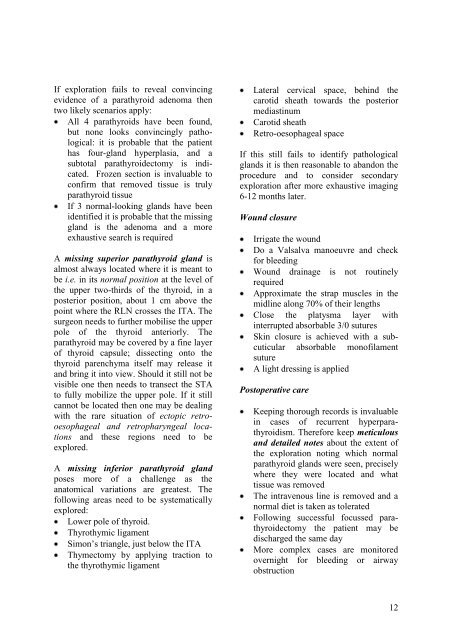Parathyroidectomy - Vula - University of Cape Town
Parathyroidectomy - Vula - University of Cape Town
Parathyroidectomy - Vula - University of Cape Town
Create successful ePaper yourself
Turn your PDF publications into a flip-book with our unique Google optimized e-Paper software.
If exploration fails to reveal convincing<br />
evidence <strong>of</strong> a parathyroid adenoma then<br />
two likely scenarios apply:<br />
All 4 parathyroids have been found,<br />
but none looks convincingly pathological:<br />
it is probable that the patient<br />
has four-gland hyperplasia, and a<br />
subtotal parathyroidectomy is indicated.<br />
Frozen section is invaluable to<br />
confirm that removed tissue is truly<br />
parathyroid tissue<br />
If 3 normal-looking glands have been<br />
identified it is probable that the missing<br />
gland is the adenoma and a more<br />
exhaustive search is required<br />
A missing superior parathyroid gland is<br />
almost always located where it is meant to<br />
be i.e. in its normal position at the level <strong>of</strong><br />
the upper two-thirds <strong>of</strong> the thyroid, in a<br />
posterior position, about 1 cm above the<br />
point where the RLN crosses the ITA. The<br />
surgeon needs to further mobilise the upper<br />
pole <strong>of</strong> the thyroid anteriorly. The<br />
parathyroid may be covered by a fine layer<br />
<strong>of</strong> thyroid capsule; dissecting onto the<br />
thyroid parenchyma itself may release it<br />
and bring it into view. Should it still not be<br />
visible one then needs to transect the STA<br />
to fully mobilize the upper pole. If it still<br />
cannot be located then one may be dealing<br />
with the rare situation <strong>of</strong> ectopic retrooesophageal<br />
and retropharyngeal locations<br />
and these regions need to be<br />
explored.<br />
A missing inferior parathyroid gland<br />
poses more <strong>of</strong> a challenge as the<br />
anatomical variations are greatest. The<br />
following areas need to be systematically<br />
explored:<br />
Lower pole <strong>of</strong> thyroid.<br />
Thyrothymic ligament<br />
Simon’s triangle, just below the ITA<br />
Thymectomy by applying traction to<br />
the thyrothymic ligament<br />
Lateral cervical space, behind the<br />
carotid sheath towards the posterior<br />
mediastinum<br />
Carotid sheath<br />
Retro-oesophageal space<br />
If this still fails to identify pathological<br />
glands it is then reasonable to abandon the<br />
procedure and to consider secondary<br />
exploration after more exhaustive imaging<br />
6-12 months later.<br />
Wound closure<br />
Irrigate the wound<br />
Do a Valsalva manoeuvre and check<br />
for bleeding<br />
Wound drainage is not routinely<br />
required<br />
Approximate the strap muscles in the<br />
midline along 70% <strong>of</strong> their lengths<br />
Close the platysma layer with<br />
interrupted absorbable 3/0 sutures<br />
Skin closure is achieved with a subcuticular<br />
absorbable mon<strong>of</strong>ilament<br />
suture<br />
A light dressing is applied<br />
Postoperative care<br />
Keeping thorough records is invaluable<br />
in cases <strong>of</strong> recurrent hyperparathyroidism.<br />
Therefore keep meticulous<br />
and detailed notes about the extent <strong>of</strong><br />
the exploration noting which normal<br />
parathyroid glands were seen, precisely<br />
where they were located and what<br />
tissue was removed<br />
The intravenous line is removed and a<br />
normal diet is taken as tolerated<br />
Following successful focussed parathyroidectomy<br />
the patient may be<br />
discharged the same day<br />
More complex cases are monitored<br />
overnight for bleeding or airway<br />
obstruction<br />
12

















